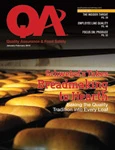Beyond the registration and records requirements of the Bioterrorism Act of 2002, the implementation of a food defense plan is still voluntary for food and beverage processing plants. However, the regulatory agencies are promoting implementation of such plans, as evidenced by activities of USDA FSIS.
Since 2006, the agency has conducted four surveys to determine food defense plan adoption rates. While rates have been gradually increasing, the 2008 survey showed only a 41 percent adoption rate, with almost all large establishments having a functional food defense plan, but most small and very small plants not.
With a goal to see at least 90 percent of all food establishments adopting functional plans, the agency issued a notice stating, "Once the results of this fourth survey [ended December 31, 2009] are compiled, the agency will use them to guide its outreach efforts and its consideration of whether to make rulemaking to require adoption and implementation of food defense plans a priority."
While food defense is still "voluntary," it would be wise for plants to review and implement defense processes, such as those in the FSIS Food Defense Plan (available at www.fsis.usda.gov/Food_Defense_&_Emergency_Response).
Following is a short-list of these:
Exterior
- Install lighting around the property and self-locking doors or alarms on emergency exits.
- Prevent unauthorized entry with locks, seals or sensors on doors and gates, windows, roof openings, vent openings, truck trailer bodies, bulk storage tanks/silos, etc.
- Conduct and document security inspections of storage facilities, including temporary storage vehicles.
- Restrict outdoor access to water wells/sources.
Shipping/Receiving
- Inspect all transport vehicles prior to loading. Monitor during loading and unloading.
- Control access to loading docks to avoid unverified or unauthorized deliveries.
- Require advance notification for all deliveries. Investigate changes in shipping documents and hold unscheduled deliveries outside premises pending verification.
- Require drivers or delivery personnel to provide identification, preferably with a photo ID. Record names.
- Require incoming shipments to be sealed with tamper-evident or numbered, documented seals and verify the seals prior to entry. Reject if seals are broken or missing.
- Check partial loads for content and condition.
Interior/Processing areas
- Install and monitor security cameras.
- Increase visibility with lighting, openness, supervision, etc.
- Regularly inventory keys to secured/sensitive areas.
- Restrict access to HVAC controls; propane, natural gas, water, electricity; disinfection systems; clean-in-place (CIP) and other centralized chemical systems.
- Keep traceability records on materials and finished product.
- Reduce the time any area is left unmonitored, as well as access to product containers or processing equipment.
- Do not allow personal items in the production area.
Storage
- Keep an access log for product and ingredient storage.
- Regularly check inventory for unexplained additions or withdrawals.
- Restrict access to internal and external storage areas.
Ingredients/Water
- Examine ingredient packages for tampering before use.
- Use water only from a municipally controlled source.
- Inspect water lines for possible tampering.
- Arrange for immediate notification by local health officials if potability of public water supply is compromised.
Chemical/Hazardous MaterialS
- Restrict access to the in-plant laboratory.
- Have procedures in place to control receipt of samples, and to receive, securely store and dispose of reagents.
Personnel
- Authorize appropriate employees to stop a process for significant concerns.
- Control all access during working and non-working hours.
- Implement a system to identify personnel with their function or department (e.g., colored uniforms, hairnets).
- Prohibit employees from removing company-provided uniforms or protective gear from the premises.
- Maintain updated shift rosters.
Records and Incident Response
- Track customer complaints/comments for trends.
- Keep food defense details confidential as necessary.
- Have current map/blueprint for local law enforcement.
- Include evacuation procedures in the food defense plan.
- Establish threat and contamination response procedures.
- Pre-establish communication with local, state and fed-eral incident response personnel for a more efficient response.

Explore the February 2010 Issue
Check out more from this issue and find your next story to read.
Latest from Quality Assurance & Food Safety
- Calbee America Launches California R&D Innovation Center
- PepsiCo Completes Acquisition of Siete Foods
- Non-GMO Project Launches Non-Ultraprocessed Foods Verification
- FDA to Hold Webinar on Updated ‘Healthy’ Claim
- High-Tech Partnership Creates Natural Blue Color for Greener Tomorrow
- Kraft Heinz Hosts Innovation Challenge for Sustainable Packaging
- FDA Requests Information on Poppy Seeds
- Danone North America Opens Applications for Annual Gut Microbiome, Yogurt and Probiotics Fellowship Grant





